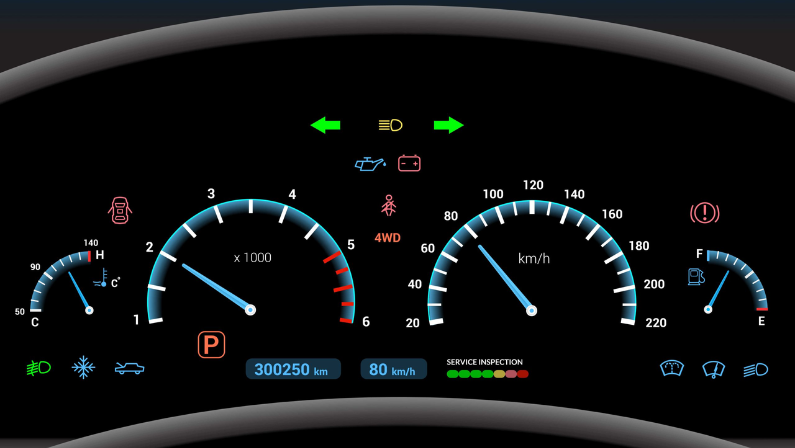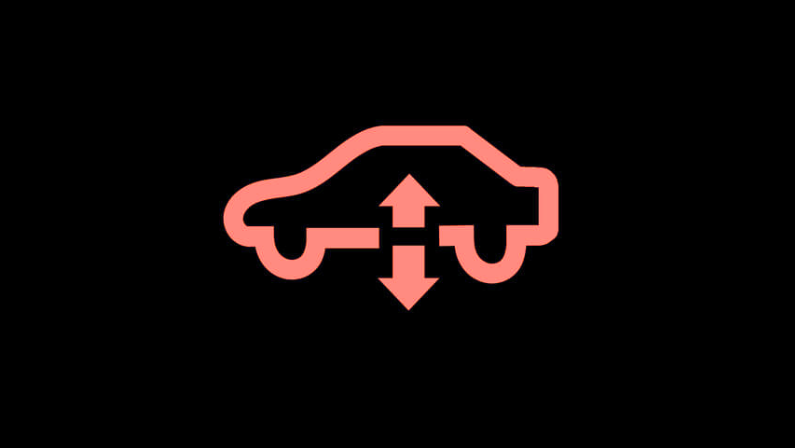Car Dashboard Warning Lights-What They Mean & How to Respond
Posted on May 15, 2025

Car warning lights on the dashboard are like its way of talking to you, signaling when something needs your attention. From a loose gas cap to a serious engine problem, these lights cover a range of issues.
They briefly illuminate when you start your car, confirming that everything is functioning properly. But when one stays on or flashes unexpectedly, it’s a sign that something may need a closer look.
Ignoring these lights can turn a small issue into a costly repair or even a safety hazard. And let’s face it — not everyone is fluent in “car talk.” Even experienced drivers can find it tricky to decode what their dashboard is saying.
In this guide, we’ll break down the most common warning lights on car dashboards, what they mean, and how you should respond to keep your car running smoothly.

Understanding Dashboard Warning Light Colors
Your car's dashboard is like its communication hub, using colored lights to alert you about its condition. These lights are usually categorized by color, indicating how urgent the issue might be.
Here's what the different colors mean:
1. Red Warning Lights
Red lights are serious and typically mean immediate attention is needed. They often indicate critical issues like low oil pressure, engine overheating, or brake system failures. If you see a red light, it's best to stop driving as soon as it's safe and address the problem.
2. Yellow/Orange Warning Lights
Yellow or orange lights suggest a problem that needs attention soon, but it’s not always an emergency. These lights often signal issues like a check engine warning, low tire pressure, or minor electrical faults. While you may be able to keep driving, getting your vehicle checked promptly is recommended.
3. Green/Blue Warning Lights
Green or blue lights are usually informational. They indicate that certain systems are operating correctly, like your high beams or cruise control. These lights don’t signal a problem, so there’s no need to worry when they appear.
Knowing what your car dashboard lights mean can help you respond appropriately and keep your car in good shape. Always refer to your owner’s manual for specific details about your vehicle’s warning lights.

Common Red Warning Lights and Their Meanings
Red warning lights indicate urgent issues that require immediate attention. Here are some common red warning lights and what they mean:
1. Oil Pressure Light
This light means your engine's oil pressure is too low, which can lead to severe engine damage.
What to do:
- Pull over and turn off the engine.
- Check the oil level and add oil if necessary.
- If the light remains on, call for roadside assistance.

2. Coolant Temperature Light
These light signals indicate that your engine is overheating, which could lead to significant damage.
What to do:
- Pull over safely and turn off the engine.
- Allow the engine to cool before checking the coolant level.
- If the coolant is low, add more and check for leaks.

3. Battery Light
A battery light usually indicates an issue with the charging system, often related to the alternator or battery itself.
What to do:
- Minimize electrical usage and drive to the nearest service center.
- If the vehicle loses power, call for assistance.

4. Transmission Temperature Light
This light warns that your transmission fluid is overheating, which can cause serious damage.
What to do:
- Pull over and let the transmission cool.
- Check the transmission fluid level if possible.
- Seek professional help if the light stays on.

5. Brake Warning Light
This light could indicate low brake fluid, a brake system malfunction, or that the parking brake is engaged.
What to do:
- Check if the parking brake is released.
- If the light remains on, check the brake fluid level.
- Get your brakes inspected immediately.

6. Airbag Warning Light
An illuminated airbag light means there’s a problem with your airbag system, which may prevent it from deploying in an accident.
What to do:
- Visit a mechanic or service center as soon as possible.
- Avoid driving until the issue is resolved for your safety.

7. Seatbelt Warning Light
This light reminds you to buckle your seatbelt. It typically stays on until the driver and passengers are properly restrained.
What to do:
- Ensure all seatbelts are fastened.
- Check for any obstructions that may prevent proper latching.

8. Security Warning Light
This light may indicate an issue with your vehicle’s security system or immobilizer, preventing the engine from starting.
What to do:
- Try using a spare key if available.
- Check the key’s battery if it has one.
- Consult your vehicle manual or contact a professional if the problem persists.

9. Power Steering Warning Light
If this light comes on, it indicates a failure in the power steering system, making it harder to steer.
What to do:
- Avoid driving long distances.
- Check the power steering fluid level if possible.
- Schedule a repair immediately.

10. Trailer Tow Hitch Warning
This light may indicate a fault with the trailer connection or wiring.
What to do:
- Ensure the trailer is properly connected.
- Check for any damaged or loose wiring.
- Seek assistance if the issue persists.

11. Parking Brake Light
This light typically stays on if the parking brake is engaged. If it remains on even when the brake is released, it could indicate a brake system issue.
What to do:
- Confirm that the parking brake is fully released.
- Check the brake fluid level.
- Visit a mechanic if the light stays on.

12. Hazard Lights On
This indicates that your hazard lights are active, often used to signal an emergency or notify other drivers of your presence.
What to do:
- Turn off the hazard lights if they were activated by mistake.
- Use them only when necessary for safety.

13. Distance Warning
This light alerts you when you are too close to another vehicle or object, often part of a collision prevention system.
What to do:
- Reduce your speed and maintain a safe following distance.
- Check your sensors for dirt or damage.

14. Air Suspension
If your vehicle has air suspension, this light indicates a fault in the system, potentially causing a rough or unstable ride.
What to do:
- Avoid driving on rough terrain.
- Get your suspension system inspected as soon as possible.
Addressing red warning lights quickly can prevent further damage and ensure your safety on the road. Always refer to your vehicle’s manual for more specific instructions.

Common Yellow or Orange Warning Lights and Their Meanings
Yellow or orange warning lights indicate a problem that needs attention, but it’s not always an immediate emergency. Here’s what some common yellow or orange lights mean:
1. Check Engine Light
This light can indicate various engine or emissions-related issues.
What to do:
- Check for any unusual sounds or reduced performance.
- Tighten the gas cap if it’s loose.
- Visit a mechanic for a diagnostic check.

2. Oil Change Warning Light
This means your vehicle is due for an oil change.
What to do:
- Schedule an oil change as soon as possible.
- Keep up with regular oil maintenance to prevent engine damage.
3. Tire Pressure Warning Light
This light indicates that one or more tires may have low air pressure.
What to do:
- Check your tire pressure using a gauge.
- Inflate tires to the recommended level.
- Inspect for any visible punctures or leaks.

4. Anti-Lock Brake Warning Light
This signals an issue with the anti-lock braking system (ABS).
What to do:
- Drive cautiously, as the ABS may not function properly.
- Get your brakes inspected immediately.
5. Traction Control Warning Light
This light means the traction control system is either off or malfunctioning.
What to do:
- Drive carefully on slippery roads.
- Have the system checked by a professional if the light stays on.

6. Stability Control Warning Light
This light indicates a problem with your vehicle’s stability control system.
What to do:
- Drive cautiously, especially in poor weather conditions.
- Have the system inspected.
7. Low Fuel Warning Light
This light simply means your fuel level is low.
What to do:
- Refuel your car as soon as possible.

8. Washer Fluid Warning Light
This indicates that the washer fluid reservoir is low.
What to do:
- Refill the washer fluid tank.
- Use appropriate fluid for seasonal conditions.
9. Lamp Out
This light means one of your exterior lights may be burned out.
What to do:
- Inspect your headlights, brake lights, and turn signals.
- Replace the faulty bulb.

10. Headlight Range Control
This light shows a malfunction in the headlight range adjustment system.
What to do:
- Adjust your headlights manually if possible.
- Schedule a repair to restore proper function.
11. Exterior Light Fault
This indicates a problem with the exterior lighting system, such as a wiring issue or blown fuse.
What to do:
- Check all exterior lights.
- Replace any faulty bulbs.
- Consult a mechanic for further diagnosis.

12. Adaptive Light System
This light signals a malfunction in your car's adaptive lighting system, which adjusts your headlights based on driving conditions.
What to do:
- Check for any obstructions on the headlights.
- Restart the vehicle to see if the light clears.
- Schedule a service if the problem persists.
13. Rear Fog Lights Switched On
This light simply indicates that your rear fog lights are on.
What to do:
- Ensure the lights are turned off when they’re no longer needed to avoid dazzling other drivers.
- Use fog lights only in poor visibility conditions.

14. Rain and Light Sensor
This light may indicate an issue with the rain or light sensor, which helps automate wipers or headlights.
What to do:
- Clean the sensor area on the windshield.
- Restart your vehicle.
- If the light remains, have the sensor checked.
15. Windshield Defrost
This light indicates that the windshield defrost function is on.
What to do:
- Let the system run until visibility improves.
- Turn it off once the windshield is clear.

16. Rear Window Defrost
This light shows that the rear window defrost function is active.
What to do:
- Allow the defrost to clear the window.
- Turn it off once it’s no longer needed.
17. Cruise Control
This light indicates that the cruise control system is active.
What to do:
- Monitor your speed and stay attentive.
- Press the brake or turn off cruise control when necessary.

18. Fuel Filter Warning
This light suggests that the fuel filter may be clogged or contaminated, particularly in diesel vehicles.
What to do:
- Avoid driving long distances.
- Replace the fuel filter as soon as possible.
- Consult a mechanic for assistance.
19. Glow Plug Indicator
Common in diesel vehicles, this light shows that the glow plugs are warming up to aid engine starting in cold weather.
What to do:
- Wait for the light to turn off before starting the engine.
- If the light stays on or flashes, seek professional inspection.
By understanding these yellow and orange warning lights, you can respond appropriately and keep your vehicle running smoothly. Refer to your owner’s manual for further details specific to your car.

Common Green or Blue Warning Lights and Their Meanings
Green or blue warning lights on your dashboard are usually informational, indicating that a system is active and working correctly.
Here’s what some common green or blue lights mean:
1. Low Beam Indicator Light
These light signals indicate that your low beam headlights are on, providing visibility in normal night driving conditions.
What to do: No action is required unless visibility changes. Ensure your headlights are on when needed.

2. High Beam Light Indicator
A blue high-beam light indicates that your high beams are on, offering extra visibility in dark or low-visibility areas.
What to do: Use high beams responsibly and switch to low beams when approaching other vehicles to avoid blinding other drivers.
3. Front Fog Lights
This green light shows that your front fog lights are on, designed to improve visibility in foggy or misty conditions.
What to do: Use fog lights only in poor visibility conditions. Turn them off when visibility improves to avoid dazzling other drivers.

4. Auto High Beam
This light indicates that your vehicle’s automatic high beam system is active, switching between high and low beams based on surrounding traffic.
What to do: No action is needed. Ensure the system is functioning properly by keeping sensors clean.
5. Side Light Indicator
Also known as parking or position lights, this green light confirms that your side lights are on, providing visibility to other drivers in low light.
What to do: Keep side lights on when parked on dimly lit roads or when driving in low visibility without needing full headlights.

6. Fan
A green fan light means your vehicle’s fan system is operating, often to regulate engine temperature or provide cabin ventilation.
What to do: No immediate action is needed. If the light stays on unexpectedly, check your climate control settings or inspect for cooling system issues.
7. Direction/Signal Indicators
These lights blink green when you activate your turn signals or hazard lights. They confirm that your indicators are working.
What to do:
- Ensure your signal lights are turning on and off correctly.
- If the blinking speed changes, it may indicate a burned-out bulb that needs replacing.

8. Lane Assist
This green light appears when the lane assist system is active, helping you stay in your lane using cameras and sensors.
What to do:
- Keep your hands on the wheel and stay attentive.
- Follow the system’s alerts if it detects unintentional lane drifting.
9. Eco Driving Indicator
The Eco Driving Indicator light turns on when you are driving in a fuel-efficient manner.
What to do:
- Maintain smooth acceleration and braking.
- Continue following eco-driving habits to improve fuel efficiency.

10. Brake Hold Indicator Light
This light turns on when the brake hold system is engaged, keeping the vehicle stationary without the need to keep your foot on the brake.
What to do:
- Ensure you understand how to activate or deactivate the brake hold feature.
- Only use it in appropriate conditions, like in stop-and-go traffic.
11. Start/Stop Warning Light
This blue or green light may appear when the start/stop system is active, automatically shutting off the engine at a stop to save fuel.
What to do:
- Allow the system to function as designed for better fuel efficiency.
- If the system malfunctions, consult a mechanic for assistance.
Understanding these green and blue lights helps you stay informed about your car's functions. Always refer to your owner’s manual for detailed information specific to your vehicle.

Preventive Maintenance to Avoid Automotive Warning Lights
Staying on top of preventative maintenance can help reduce the chances of seeing warning lights on your dashboard. Here are some essential maintenance tips to keep your car running smoothly:
1. Regular Oil Changes and Fluid Checks
Engine oil and other fluids, like coolant, brake fluid, and transmission fluid, are vital for your car’s performance.
- Follow the manufacturer’s recommended oil change schedule.
- Check fluid levels regularly and top them off when necessary.
- Look for any leaks under your car and address them promptly.

2. Routine Tire Pressure and Brake Inspections
Proper tire pressure and well-maintained brakes are essential for safety and fuel efficiency.
- Check your tire pressure monthly and adjust it to the recommended levels.
- Inspect your tires for signs of wear or damage.
- Have your brake pads, rotors, and fluid checked during routine service.
3. Keeping an Eye on Battery Health and Electrical Systems
A weak or failing battery can trigger warning lights related to the charging or electrical system.
- Test your battery regularly, especially before extreme weather changes.
- Ensure battery terminals are clean and corrosion-free.
- Have your alternator and other electrical components inspected as part of routine maintenance.

4. Do Not Ignore Warning Lights
If a warning light does appear, it’s important to address it right away to prevent further damage.
- Refer to your owner’s manual to understand the meaning of the light.
- Take immediate action if it’s a red or flashing light.
- Schedule a diagnostic check with a trusted mechanic for any persistent warnings.
Regular maintenance can help you avoid unexpected issues to ensure your car remains safe and reliable on the road.

Stay Safe by Understanding Your Car’s Dashboard Warning Lights
Understanding your car's dashboard warning lights can help you catch potential issues early and keep your vehicle running smoothly. Whether it’s a reminder to check your oil or a more serious alert, knowing what each light means ensures you respond appropriately.
If you ever need expert advice or professional service, CarHub North York Chrysler has you covered. Our technicians are here to diagnose and fix any issue with care and precision.
For more helpful car tips and insights, check out our Blog page — your go-to resource for all things automotive.
